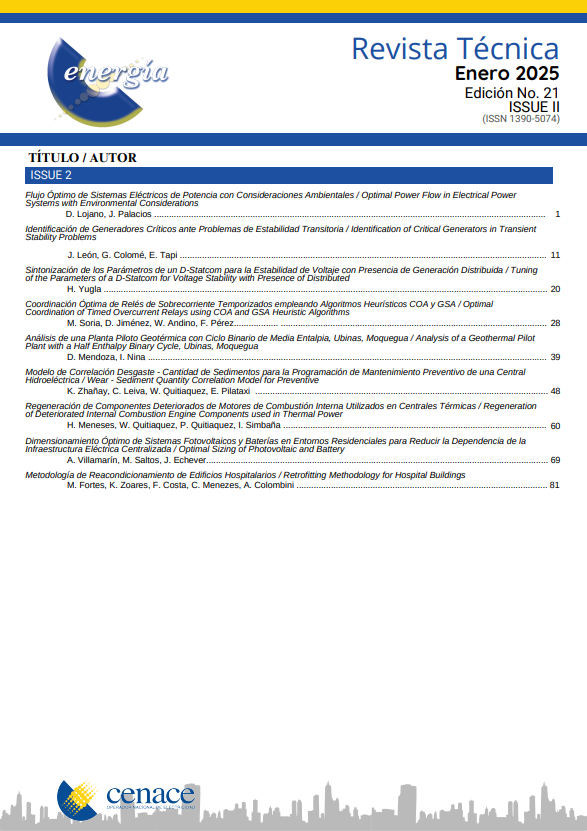Identificación de Generadores Críticos ante Problemas de Estabilidad Transitoria
Contenido principal del artículo
Resumen
La literatura ha prestado atención a la estabilidad transitoria, centrándose en su evaluación y control en situaciones operativas y contingencias limitadas. Esto con frecuencia conduce a problemas de estabilidad transitoria no contemplados en los estudios que hacen que el sistema sea susceptible a colapsos inminentes. En este sentido, este trabajo propone una metodología para identificar los generadores críticos bajo un amplio universo de escenarios de operación y contingencias, sirviendo como base para el desarrollo de un esquema de desconexión adaptable que responda a la dinámica en tiempo real del sistema. La metodología se basa en la generación de una base de datos con un amplio espectro de escenarios operativos y contingencias N-1, así como la desconexión sistemática de generadores que permita identificar aquellos denominados como críticos para la mitigación de inestabilidad transitoria. En un entorno de simulación controlado (sistema IEEE de 39 barras en el software DigSILENT Power Factory), la metodología encontró con efectividad los generadores críticos en un 99.6 % de los casos simulados que fueron identificados como inestables por estabilidad transitoria, determinando así una base sólida para el entrenamiento de un modelo de aprendizaje que actúe en tiempo real según la dinámica del sistema, lo que se traduce en un esquema de desconexión de generación adaptable.
Descargas
Detalles del artículo

Esta obra está bajo una licencia internacional Creative Commons Atribución-NoComercial 4.0.
Aviso de Derechos de Autor
La Revista Técnica "energía" está bajo licencia internacional Creative Commons Reconocimiento-NoComercial 4.0.
Citas
J. D. E. Echeverria, C. J. C. Cepeda, and D. G. Colome, “Real-time transient stability assessment of electric power systems using predictive-SIME based on machine learning,” in 2017 IEEE PES Innovative Smart Grid Technologies Conference - Latin America (ISGT Latin America), IEEE, Sep. 2017, pp. 1–6.
M. Pavella, D. Ernst, and D. Ruiz-Vega, “TRANSIENT STABILITY OF POWER SYSTEMS A Unified Approach to Assessment and Control.”, Springer. 2000.
M. Pavella and P. G. Murthy, Transient stability of power systems: theory and practice, Wiley. 1994.
E. A. T. Suarez and D. G. Colome, “Evaluación de la Estabilidad de Corto Plazo y Discriminación de Inestabilidades Transitoria y de Tensión,” in 2022 IEEE Biennial Congress of Argentina (ARGENCON), IEEE, Sep. 2022, pp. 1–7.
“Definition and Classification of Power System Stability IEEE/CIGRE Joint Task Force on Stability Terms and Definitions,” IEEE Transactions on Power Systems, vol. 19, no. 3, pp. 1387–1401, Aug. 2004.
V. Van Acker, P. Cholley, P. Crossley, C. W. Taylor, and C. Vournas, “SYSTEM PROTECTION SCHEMES IN POWER NETWORKS,” CIGRE. 2001.
V. H. Hinojosa, “Pronóstico de la demanda de corto plazo en sistemas de suministro de energía eléctrica utilizando inteligencia artificial,” San Juan, 2007.
J. L. Rueda, “Evaluación y mejora de la estabilidad de pequeña señal de sistemas eléctricos de potencia considerando incertidumbres,” San Juan, 2009.
J. Cepeda, “Evaluación de la Vulnerabilidad del Sistema Eléctrico de Potencia en tiempo real usando Tecnología de Medición Sincrofasoria,” Universidad Nacional de San Juan, San Juan, 2013.
L. Wenyuan, Risk assessment of power systems: models, methods, and applications. A Jhon Wiley & Sons, 2005.
R. Zhang, Y. Xu, Z. Y. Dong, and K. P. Wong, “Post‐disturbance transient stability assessment of power systems by a self‐adaptive intelligent system,” IET Generation, Transmission & Distribution, vol. 9, no. 3, pp. 296–305, Feb. 2015.
A. D. Rajapakse, F. Gomez, K. Nanayakkara, P. A. Crossley, and V. V. Terzija, “Rotor Angle Instability Prediction Using Post-Disturbance Voltage Trajectories,” IEEE Transactions on Power Systems, vol. 25, no. 2, pp. 947–956, May 2010.
NR Electric Co. Ltd, “PCS-996 Phasor Measurement Unit,” 2019.
T. B. Nguyen and M. A. Pai, “Dynamic security-constrained rescheduling of power systems using trajectory sensitivities,” IEEE Transactions on Power Systems, vol. 18, no. 2, pp. 848–854, May 2003.
DigSilent GmbH, “Synchronous Machine,” Gomaringen Germany, 2018
DIgSILENT GmbH, “Induction Machine TechRef ElmAsm V2.1,” Gomaringen, Germany, 2010.
D. E. Echeverria Jurado, J. C. Cepeda Campana, and D. Graciela Colome, “Predicción de la Estabilidad Transitoria de Sistemas Eléctricos utilizando Aprendizaje Automático,” in 2022 IEEE Biennial Congress of Argentina (ARGENCON), IEEE, Sep. 2022, pp. 1–8.



